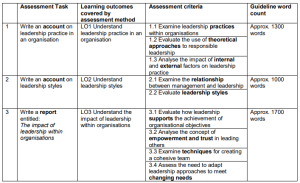- CIPD level 5HR02 Assignment: Talent Management and Workforce Planning Unit Guide
- Level 3 D/615/3823 Assignment: Regulation, Protection, and Collaborative Practice in Health and Social Care
- ILM Level 4 Assignment 01: Developing Leadership Styles: An Action Plan for Effective Leadership and Team Engagement
- Level 6 Unit T/615/2726 Assignment: Strategic Project Management: Identifying, Planning, and Controlling Projects for Business Success
- EDD-U1-T4 Assignment: Internal and External Support Services for Educational Practitioners
- Discussion Paper on Market Forces and Government Interventions for Business Leaders
- Unit 10 Customer Relationship Management Assignment – CRM Processes & Stakeholder Roles
- CIPD 7HR02 Resourcing and Talent Management to Sustain Success
- Athe Level 3 Health and Social Care Assessment Questions
- M/618/4168 Unit 2 Principles, Values and Regulation in the Health and Social Care Sector – ATHE Level 3
- ILM Communication Skills Self-Assessment
- ILM Unit 8600-309: Understand How to Establish an Effective Team
- CMI Unit 525 Using Reflective Practice to Inform Personal and Professional Development
- Understand and Work with a Wide Range of Stakeholders and Organisational Structures – Assignment 1
- Assessment: Financial Performance Evaluation of Savory Snacks Company Ltd for Credit
- CMI L5 Assignment: Managing Stakeholder Relationships: Strategies, Challenges, and Best Practices
- Level 3 Unit 2 Assignment: Principles, Values and Regulation in the Health and Social Care Sector
- COM4006 Assignment: Introduction to Academic Skills and Professional Development
- Assessment: Managing Organisational Change: Evaluating Strategies, Challenges, and Impact
- UNIT CMI 706 Assignment: Finance for Strategic Leaders: The Role, Scope, and Impact of Finance
CMI 526 Assessment: Principles of Leadership Practice
| University | The Open University (OU) |
| Subject | 5OS06 Leadership and Management Development |
Overview of assessment tasks
Each task in this assessment brief has been developed to enable you to evidence achievement of the learning
outcomes and assessment criteria for CMI 526: Principles of Leadership Practice. Each of the assessment
criteria must gain a pass outcome for you to successfully achieve the unit.
Preparation for the assessment
● Before you begin the assessment brief please read the CMI 526 unit specification thoroughly as only the
content related to the achievement of the assessment criteria will be assessed.
● Research the topics being assessed. Suggested reading/web resources are provided on the CMI 526 unit
specification. Your tutor may signpost you to relevant resources. Additionally, you may access excellent online
resources at ManagementDirect https://members.md.cmi.org.uk. Please note that if you have a customised site the
link will differ, please contact your Centre for clarification.
● If you are enrolled on the Trailblazer Apprenticeship programme you are encouraged to review the
Apprenticeship Standard for Operations/Departmental Manager.
Completing the assessment brief
● The assessment brief contains a series of tasks which are clearly referenced to the relevant assessment
criteria and indicative content.
● Refer to the Assessment Guidance Table at the end of the assessment brief which outlines the requirements
for a Pass or Refer.
● Evidence must be provided in the evidence booklet. Additional work based evidence such as plans or
documentation (which has been referred to within the main text) should be included at the end of the booklet
marked ‘Work Based Evidence’. Appendices are not a requirement of this assessment brief. If appendices are
included these will not be marked or moderated by the CMI.
● Work based evidence must be accompanied by a supporting statement in the learner evidence box, to explain
the link to the assessment criteria. Work based evidence (where required by the task) must not exceed SIX (6)
pages. Files embedded in the booklet must not exceed 10MB.
● The evidence booklet must be completed in a professional manner (e.g. applying business conventions for
writing formal reports) and by using Microsoft Word, Rich Text Format or another compatible software
programme and not in a PDF format.
● An appropriate referencing system (such as Harvard Referencing) must be used to ensure the original
source(s) of quotations or models can be verified.
● Finally, you must sign the Learner Authenticity statement (an electronic signature is accepted).
Learner support For information regarding policies and procedures for assessment (e.g. special assessment arrangements, learner
support, appeals, complaints, certification, confidentiality, plagiarism) you should contact your tutor or Centre
manager and refer to the CMI Level 5 in Management and Leadership syllabus.
INTRODUCING ASSESSMENT BRIEF CMI 526
Assessment brief CMI 526 has been designed to develop managers’ understanding of ethical leadership and the
impact of culture and values on leadership. Managers will examine leadership models and the concept of
empowerment, with consideration of techniques and methods for leading others.
ASSESSMENT TASKS AND WORD COUNT
Assessment brief 526 features the following assessment tasks. Further detail is provided against each assessment
task within the brief.

Do You Need Assignment of This Question
Guideline word count
The written word, however generated and recorded, is still expected to form the majority of assessable work
produced by Learners at Level 5. The amount and volume of work for this unit should be broadly comparable to a
word count of 3500-4000 words within a margin of +/-10%. The excessive use of word count is not grounds for
referral, however the CMI reserve the right to return work to the Centre for editing and resubmission by the
Learner.
The following are excluded from inclusion in word count, if used and not required by the assessment brief: an
introduction to a job role, organisation or department, index or contents pages, headings and sub headings,
diagrams, charts and graphs, reference list or bibliography, reflective statement drawn from undertaking the
assignment and how this has impacted on the learner’s work.
Please see the CMI Assessment Guidance Policy for further guidance.
LEADERSHIP PRACTICE IN AN ORGANISATION
Effective leadership practice is required to support individuals and teams. Whilst it has many characteristics, it
needs to be resilient, able to respond to internal and external factors, all of which have the ability to impact on the
leader’s success.
TASK 1
Using examples, write an account on leadership practice in an organisation. The account must:
i. Examine leadership practices within organisations (AC1.1)
ii. Evaluate the use of TWO (2) theoretical approaches to responsible leadership (AC1.2)
iii. Analyse the impact of TWO (2) internal and TWO (2) external factors on leadership practice (AC1.3)
LEADERSHIP STYLES
There is much debate about the definitions for leadership and management, and the relationship between them. By
understanding their relationship and the way leadership styles can be applied in a variety of contexts, a leader will
be equipped with the knowledge to lead others in the workplace.
SCENARIO
You manage a department in a medium sized organisation. Following a successful year that has seen significant
growth in sales, the organisation has ambitious plans to re-locate to a new business park (40 miles away from its
current location).
A number of staff within your department have chosen not to re-locate with the organisation so there will be
vacancies in your team.
The team members that have decided to move with the company are concerned about the re-location and how the
new team will gel in time to achieve challenging targets.
You are responsible for the recruitment and selection of new staff and leading team members to be effective in their
roles.
The objectives are for all departments to meet new operational targets within 3 months of the move.
TASK 2
Basing your response on the scenario, your own experience of leading individuals and teams or using well chosen
examples from an organisation you know well or have researched:
Write an account which:
i. Examines the relationship between management and leadership (AC2.1)
ii. Evaluates THREE (3) leadership styles which can be used in organisations (AC2.2)
THE IMPACT OF LEADERSHIP WITHIN ORGANISATIONS
Leadership has the power to impact on the achievement of organisational objectives. It is essential for leaders to
empower others, develop trust among those they manage and create cohesive teams which are adaptable to
change.
TASK 3
Basing your response on the scenario, your own experience of leading individuals and teams or using well chosen
examples from an organisation you know well or have researched:
You are required to write a report entitled ‘The impact of leadership within organisations’. The report must use examples to:
i. Evaluate how leadership supports the achievement of organisational objectives (AC3.1)
ii. Analyse the concept of empowerment and trust in leading others (AC3.2)
iii. Examine THREE (3) techniques for creating a cohesive team (AC3.3)
iv. Assess the need to adapt leadership approaches to meet changing needs (AC3.4)
Buy Answer of This Assessment & Raise Your Grades



